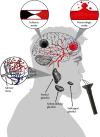Salivary Biomarkers of Oxidative Stress and Inflammation in Stroke Patients: From Basic Research to Clinical Practice
- PMID: 33897941
- PMCID: PMC8052150
- DOI: 10.1155/2021/5545330
Salivary Biomarkers of Oxidative Stress and Inflammation in Stroke Patients: From Basic Research to Clinical Practice
Abstract
Cerebral stroke is a serious worldwide health problem, as can be seen by the global epidemic of the disease. In this disorder, when the blood flow is compromised by ruptures or blocked arteries, sudden death of neurons is observed as a result of a lack of oxygen and nutrients. Numerous severe problems and frequent complications also exist in stroke patients; therefore, there is an urgent need to develop new therapeutic, diagnostic, and prognostic methods for the disease. At present, the diagnosis of stroke is based on a neurological examination, medical history, and neuroimaging, due to the fact that rapid and noninvasive diagnostic tests are unavailable. Nevertheless, oxidative stress and inflammation are considered key factors in stroke pathogenesis. Oxygen free radicals are responsible for oxidation of lipids, proteins, and DNA/RNA, which in turn contributes to oxidative damage of the brain. Toxic products of the oxidation reactions act cytostatically on the cell by damaging cell membranes and leading to neuronal death by apoptosis or necrosis. Thus, it seems that redox/inflammatory biomarkers might be used in the diagnosis of the disease. Nowadays, saliva is of increasing interest in clinical laboratory medicine. Redox biomarkers could be obtained easily, noninvasively, cheaply, and stress-free from saliva. This minireview is aimed at presenting the current knowledge concerning the use of salivary biomarkers of oxidative stress and inflammation in the diagnosis and prognosis of stroke.
Copyright © 2021 Mateusz Maciejczyk et al.
Conflict of interest statement
The authors declare no conflict of interest.
Figures



Similar articles
-
Salivary Antioxidant Barrier, Redox Status, and Oxidative Damage to Proteins and Lipids in Healthy Children, Adults, and the Elderly.Oxid Med Cell Longev. 2019 Dec 5;2019:4393460. doi: 10.1155/2019/4393460. eCollection 2019. Oxid Med Cell Longev. 2019. PMID: 31885792 Free PMC article.
-
Salivary biomarkers of oxidative stress: A critical review.Free Radic Biol Med. 2015 Aug;85:95-104. doi: 10.1016/j.freeradbiomed.2015.04.005. Epub 2015 Apr 16. Free Radic Biol Med. 2015. PMID: 25889823 Review.
-
Antioxidant Defence, Oxidative Stress and Oxidative Damage in Saliva, Plasma and Erythrocytes of Dementia Patients. Can Salivary AGE be a Marker of Dementia?Int J Mol Sci. 2017 Oct 20;18(10):2205. doi: 10.3390/ijms18102205. Int J Mol Sci. 2017. PMID: 29053628 Free PMC article.
-
Oxidative stress biomarkers in the perinatal period: Diagnostic and prognostic value.Semin Fetal Neonatal Med. 2020 Apr;25(2):101087. doi: 10.1016/j.siny.2020.101087. Epub 2020 Jan 23. Semin Fetal Neonatal Med. 2020. PMID: 32008959 Review.
-
Salivary Redox Biomarkers in Selected Neurodegenerative Diseases.J Clin Med. 2020 Feb 12;9(2):497. doi: 10.3390/jcm9020497. J Clin Med. 2020. PMID: 32059422 Free PMC article. Review.
Cited by
-
Role of Polyphenols as Antioxidant Supplementation in Ischemic Stroke.Oxid Med Cell Longev. 2021 Jun 25;2021:5471347. doi: 10.1155/2021/5471347. eCollection 2021. Oxid Med Cell Longev. 2021. PMID: 34257802 Free PMC article. Review.
-
"The effects of non-surgical periodontal treatment plus zinc and magnesium supplementation on oxidative stress and antioxidants enzymes in type 2 diabetes patients: a quasi-experimental study".BMC Oral Health. 2024 Aug 4;24(1):892. doi: 10.1186/s12903-024-04688-7. BMC Oral Health. 2024. PMID: 39098894 Free PMC article.
-
Application of a Novel Biosensor for Salivary Conductivity in Detecting Chronic Kidney Disease.Biosensors (Basel). 2022 Mar 17;12(3):178. doi: 10.3390/bios12030178. Biosensors (Basel). 2022. PMID: 35323448 Free PMC article.
-
Oxidative alterations in exfoliated oral mucosa cells of patients with major depressive disorder.J Oral Biol Craniofac Res. 2025 Mar-Apr;15(2):256-261. doi: 10.1016/j.jobcr.2025.01.026. Epub 2025 Feb 10. J Oral Biol Craniofac Res. 2025. PMID: 40027854 Free PMC article.
-
Salivary chemokines and growth factors in patients with ischemic stroke.Sci Rep. 2025 Apr 12;15(1):12676. doi: 10.1038/s41598-025-97974-5. Sci Rep. 2025. PMID: 40221607 Free PMC article.
References
-
- Mirzaee O., Saneian M., Vani J. R., et al. The psychophysiological responses of the chronic ischemic stroke patients to the acute stress were changed. Brazilian Archives of Biology and Technology. 2019;62 doi: 10.1590/1678-4324-2019180494. - DOI
Publication types
MeSH terms
Substances
LinkOut - more resources
Full Text Sources
Other Literature Sources
Medical

